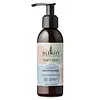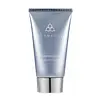What's inside
What's inside
 Key Ingredients
Key Ingredients

 Benefits
Benefits

 Concerns
Concerns

 Ingredients Side-by-side
Ingredients Side-by-side

Water
Skin ConditioningCaprylic/Capric Triglyceride
MaskingAloe Barbadensis Leaf Juice
Skin ConditioningCetyl Alcohol
EmollientGlycerin
HumectantGlyceryl Stearate
EmollientAcronychia Acidula Fruit Extract
HumectantEucalyptus Olida Leaf Extract
Skin ConditioningAlthaea Officinalis Root Extract
Skin ConditioningEpilobium Angustifolium Flower/Leaf/Stem Extract
Skin ConditioningCydonia Oblonga Leaf Extract
Skin ConditioningCamellia Sinensis Leaf Extract
AntimicrobialMoringa Oleifera Leaf Extract
Skin ConditioningSalvia Officinalis Leaf Extract
CleansingCocos Nucifera Fruit Extract
EmollientChamomilla Recutita Flower Extract
MaskingSodium Stearoyl Glutamate
CleansingXanthan Gum
EmulsifyingSodium Metabisulfite
AntioxidantPotassium Sorbate
PreservativeSodium Benzoate
MaskingPhenoxyethanol
PreservativeBenzyl Alcohol
PerfumingCitric Acid
BufferingWater, Caprylic/Capric Triglyceride, Aloe Barbadensis Leaf Juice, Cetyl Alcohol, Glycerin, Glyceryl Stearate, Acronychia Acidula Fruit Extract, Eucalyptus Olida Leaf Extract, Althaea Officinalis Root Extract, Epilobium Angustifolium Flower/Leaf/Stem Extract, Cydonia Oblonga Leaf Extract, Camellia Sinensis Leaf Extract, Moringa Oleifera Leaf Extract, Salvia Officinalis Leaf Extract, Cocos Nucifera Fruit Extract, Chamomilla Recutita Flower Extract, Sodium Stearoyl Glutamate, Xanthan Gum, Sodium Metabisulfite, Potassium Sorbate, Sodium Benzoate, Phenoxyethanol, Benzyl Alcohol, Citric Acid
Water
Skin ConditioningGlycerin
HumectantIsodecyl Neopentanoate
EmollientGlyceryl Stearate
EmollientCoconut Alkanes
EmollientGluconolactone
Skin ConditioningSodium Levulinate
Skin ConditioningNiacinamide
SmoothingSyringa Vulgaris Extract
Skin ConditioningCarnitine
CleansingTrehalose
HumectantOpuntia Ficus-Indica Stem Extract
Skin ConditioningAloe Barbadensis Leaf Juice Powder
Skin ConditioningPolyglyceryl-4 Caprate
EmulsifyingCoco-Caprylate/Caprate
EmollientXanthan Gum
EmulsifyingCetyl Alcohol
EmollientStearyl Alcohol
EmollientCarbomer
Emulsion StabilisingMaltodextrin
AbsorbentSodium Benzoate
MaskingSodium Hydroxide
BufferingPotassium Sorbate
PreservativeSodium Anisate
AntimicrobialFarnesol
PerfumingCalcium Gluconate
HumectantPhenoxyethanol
PreservativeLavandula Angustifolia Extract
Skin ConditioningCaprylic/Capric Triglyceride
MaskingCamellia Sinensis Leaf Extract
AntimicrobialMentha Piperita Extract
CleansingRubus Occidentalis Fruit Extract
AstringentCitrus Aurantium Amara Flower Extract
RefreshingPyrus Malus Fruit Extract
Skin ConditioningRosmarinus Officinalis Leaf Extract
AntimicrobialSalvia Officinalis Leaf Extract
CleansingCitrus Aurantium Bergamia Fruit Extract
Skin ConditioningCupressus Sempervirens Leaf Extract
PerfumingWater, Glycerin, Isodecyl Neopentanoate, Glyceryl Stearate, Coconut Alkanes, Gluconolactone, Sodium Levulinate, Niacinamide, Syringa Vulgaris Extract, Carnitine, Trehalose, Opuntia Ficus-Indica Stem Extract, Aloe Barbadensis Leaf Juice Powder, Polyglyceryl-4 Caprate, Coco-Caprylate/Caprate, Xanthan Gum, Cetyl Alcohol, Stearyl Alcohol, Carbomer, Maltodextrin, Sodium Benzoate, Sodium Hydroxide, Potassium Sorbate, Sodium Anisate, Farnesol, Calcium Gluconate, Phenoxyethanol, Lavandula Angustifolia Extract, Caprylic/Capric Triglyceride, Camellia Sinensis Leaf Extract, Mentha Piperita Extract, Rubus Occidentalis Fruit Extract, Citrus Aurantium Amara Flower Extract, Pyrus Malus Fruit Extract, Rosmarinus Officinalis Leaf Extract, Salvia Officinalis Leaf Extract, Citrus Aurantium Bergamia Fruit Extract, Cupressus Sempervirens Leaf Extract
 Reviews
Reviews

Ingredients Explained
These ingredients are found in both products.
Ingredients higher up in an ingredient list are typically present in a larger amount.
Camellia Sinensis Leaf Extract is derived from the leaves of the tea plant. Black tea, green tea, and oolong tea are all harvested from this plant.
This ingredient has many skin benefits:
This ingredient contains polyphenols, a strong antioxidant. Antioxidants help fight off molecules that damage skin cells.
On top of that, the antioxidants in green tea neutralize free-radicals from the sun. This gives the skin some extra UV protection, but should not replace sunscreen.
Many components of tea have anti-inflammatory properties.
Polyphenols and L-theanine help soothe the skin and reduce irritation. The caffeine in Camellia Sinensis Leaf Extract helps calm inflamed blood vessels.
Other compounds found in tea include: Vitamin Bs, linoleic acid, magnesium, calcium, iron, and zinc.
Research has shown both drinking Camellia Sinensis Leaf Tea and applying it to the skin can help boost skin elasticity and hydration. Studies also show using tea extract may reduce sebum, or oil, production.
Learn more about Camellia Sinensis Leaf ExtractThis ingredient is an emollient, solvent, and texture enhancer. It is considered a skin-softener by helping the skin prevent moisture loss.
It helps thicken a product's formula and makes it easier to spread by dissolving clumping compounds.
Caprylic Triglyceride is made by combining glycerin with coconut oil, forming a clear liquid.
While there is an assumption Caprylic Triglyceride can clog pores due to it being derived from coconut oil, there is no research supporting this.
Learn more about Caprylic/Capric TriglycerideCetyl Alcohol is a fatty alcohol. Fatty Alcohols are most often used as an emollient or to thicken a product.
Its main roles are:
Though it has "alcohol" in the name, it is not related to denatured alcohol or ethyl alcohol.
The FDA allows products labeled "alcohol-free" to have fatty alcohols.
Learn more about Cetyl AlcoholGlycerin is already naturally found in your skin. It helps moisturize and protect your skin.
A study from 2016 found glycerin to be more effective as a humectant than AHAs and hyaluronic acid.
As a humectant, it helps the skin stay hydrated by pulling moisture to your skin. The low molecular weight of glycerin allows it to pull moisture into the deeper layers of your skin.
Hydrated skin improves your skin barrier; Your skin barrier helps protect against irritants and bacteria.
Glycerin has also been found to have antimicrobial and antiviral properties. Due to these properties, glycerin is often used in wound and burn treatments.
In cosmetics, glycerin is usually derived from plants such as soybean or palm. However, it can also be sourced from animals, such as tallow or animal fat.
This ingredient is organic, colorless, odorless, and non-toxic.
Glycerin is the name for this ingredient in American English. British English uses Glycerol/Glycerine.
Learn more about GlycerinGlyceryl Stearate is a mix of glycerin and stearic acid.
It is used to stabilize the mixing of water and oil ingredients. By preventing these ingredients from separating, it can help elongate shelf life. It can also help thicken the product's texture.
As an emollient, it helps soften skin and supports barrier-replenishing ingredients.
In cosmetics, Glyceryl Stearate is often made from vegetable oils or synthetically produced.
This ingredient may not be fungal-acne safe
Fun fact: The human body also creates Glyceryl Stearate naturally.
Learn more about Glyceryl StearatePhenoxyethanol is a preservative that has germicide, antimicrobial, and aromatic properties. Studies show that phenoxyethanol can prevent microbial growth. By itself, it has a scent that is similar to that of a rose.
It's often used in formulations along with Caprylyl Glycol to preserve the shelf life of products.
Potassium Sorbate is a preservative used to prevent yeast and mold in products. It is commonly found in both cosmetic and food products.
This ingredient comes from potassium salt derived from sorbic acid. Sorbic acid is a natural antibiotic and effective against fungus.
Both potassium sorbate and sorbic acid can be found in baked goods, cheeses, dried meats, dried fruit, ice cream, pickles, wine, yogurt, and more.
You'll often find this ingredient used with other preservatives.
Learn more about Potassium SorbateSage leaf extract is a culinary and medicinal herb with antibacterial, antioxidant, and soothing properties.
This ingredient is made up of 75-90% ursolic acid, a potent antioxidant and anti-inflammatory compound.
Sodium Benzoate is a preservative. It's used in both cosmetic and food products to inhibit the growth of mold and bacteria. It is typically produced synthetically.
Both the US FDA and EU Health Committee have approved the use of sodium benzoate. In the US, levels of 0.1% (of the total product) are allowed.
Sodium benzoate works as a preservative by inhibiting the growth of bacteria inside of cells. It prevents the cell from fermenting a type of sugar using an enzyme called phosphofructokinase.
It is the salt of benzoic acid. Foods containing sodium benzoate include soda, salad dressings, condiments, fruit juices, wines, and snack foods.
Studies for using ascorbic acid and sodium benzoate in cosmetics are lacking, especially in skincare routines with multiple steps.
We always recommend speaking with a professional, such as a dermatologist, if you have any concerns.
Learn more about Sodium BenzoateWater. It's the most common cosmetic ingredient of all. You'll usually see it at the top of ingredient lists, meaning that it makes up the largest part of the product.
So why is it so popular? Water most often acts as a solvent - this means that it helps dissolve other ingredients into the formulation.
You'll also recognize water as that liquid we all need to stay alive. If you see this, drink a glass of water. Stay hydrated!
Learn more about WaterXanthan gum is used as a stabilizer and thickener within cosmetic products. It helps give products a sticky, thick feeling - preventing them from being too runny.
On the technical side of things, xanthan gum is a polysaccharide - a combination consisting of multiple sugar molecules bonded together.
Xanthan gum is a pretty common and great ingredient. It is a natural, non-toxic, non-irritating ingredient that is also commonly used in food products.
Learn more about Xanthan Gum